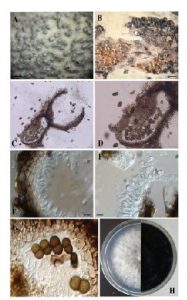Dothiorella magnoliae C.M. Tian, C.J. You sp. nov., MycoBank Number: MB 821470
Etymology : magnoliae, referring to Magnolia grandiflora, the only host known for this species.
Conidiogenesis : Conidiomata pycnidial, abundant, superficial, or semi-immersed, separate or aggregated into botryose cluster. Conidiogenesis holoblastic, with hyaline and cylindrical conidiogenous cells giving rise to periclinal thickenings. Conidia initially hyaline, thin-walled, nonseptate, becoming thick-walled, brown, 1-septate prior to release from the conidiogenous cells, always deeply constricted at septum, externally smooth, internally finely verruculose, rounded at both ends, (16.00–) 20.63–22.50 (–31.35) × (8.14–) 10.87–12.03(–15.55) (av. of 50 conidia = 21.56 × 11.45 µm), and an average length to width ratio of 1.88.
Cultural characteristics : on PDA colonies flat and filamentous, initially leaden grey in the centre, becoming smoke grey at the margin, with white appressed mycelia radiating outwards, forming smoke-grey to olivaceous-dark at the surface and brown-dark at the reverse after 7–10 days. Colonies extending to ca. 66 mm diam after two weeks in the dark at room temperature.
Known distribution : Southwestern China.
Material examined : CHINA, Sichuan Province: Daofu, 29°59’36″N, 101°53’46″E, 3183 m asl, on twigs and branches of Magnolia grandiflora, coll. C.J. You, 10 June 2015 (BJFC-S2323, holotype), ex-type culture, CFCC 51563; Daofu, 29°59’36″N, 101°53’46″E, 3183 m asl, on twigs and branches of Magnolia grandiflora, coll. C.J. You, 10 June 2015 (BJFC-S2324, paratype), ex-paratype culture, CFCC 51564.
Notes : Dothiorella magnoliae differs from other species of Dothiorella in having 1-septate conidia deeply constricted at the septum (Fig. 1) (Table 2). Morphologically, D. magnoliae resembles D. westralis (W. M. Pitt et al.) Tao Yang & Crous (mean L/W: 1.9), but differs from this species in its larger conidia with rounded apex and base. The conidial size of D. magnoliae is comparable with those of D. plurivora (Abdollahz. et al.) Tao Yang & Crous (Table 2), but they differ in conidial shapes in that most conidia of D. plurivora have a truncate base, while those of D. magnoliae are unique with rounded ends (Abdollahzadeh et al. 2014, Yang et al. 2017)
FIG 2. Dothiorella magnoliae (Holotype CFCC 51563). A–B Black conidiomata on the host surface. C–D Vertical section of conidioma. E Section of peridium. F Conidiogenous cells and developing conidia. G Mature brown 1-septate conidia. H Culture on PDA (seven and 28 day-old colonies). Scale bars: A = 2 mm, B = 2000 μm, C, D, = 20 μm, E, F, G = 10 μm.

